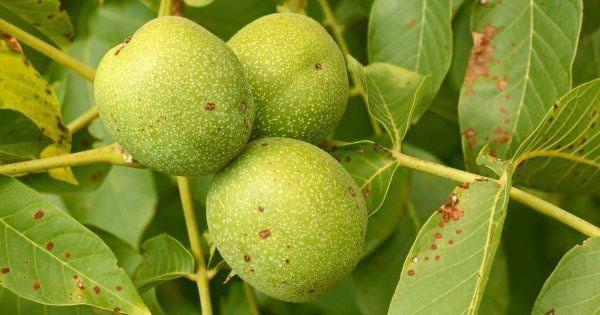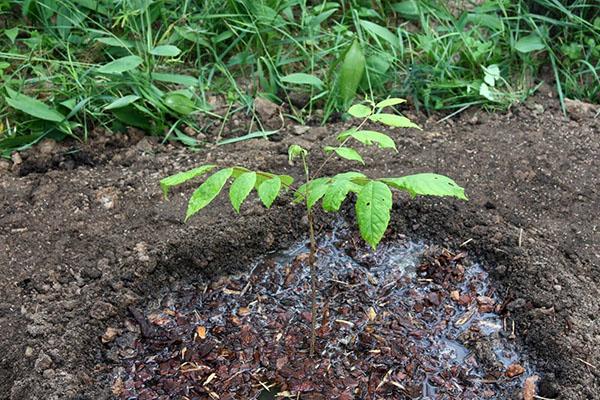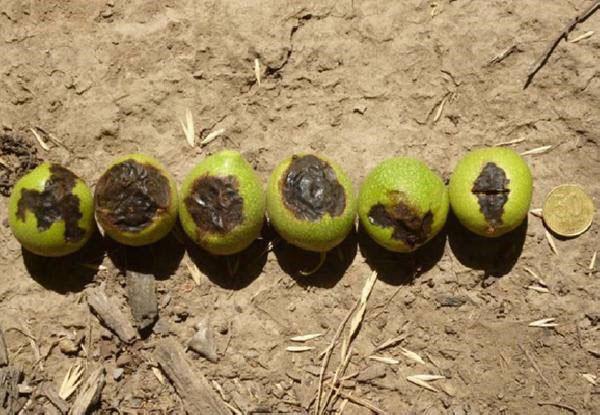Walnut diseases: we make the correct diagnosis
 Growing this tasty and healthy fruit brings a lot of income to gardeners. Nevertheless, walnut diseases drastically reduce its yield. Despite its popularity, the walnut tree is very often affected by various kinds of fungal spores. Knowing them in person and understanding how to deal with them, the farmer will be able to get a decent profit from his estate.
Growing this tasty and healthy fruit brings a lot of income to gardeners. Nevertheless, walnut diseases drastically reduce its yield. Despite its popularity, the walnut tree is very often affected by various kinds of fungal spores. Knowing them in person and understanding how to deal with them, the farmer will be able to get a decent profit from his estate.
Walnut disease: an epicrisis of an unusual patient

This often happens due to:
- improper cultivation techniques;
- unsuitable landing site: lack of light or excess moisture (close occurrence of groundwater);
- unacceptable soil composition.
All of these conditions exacerbate the problem, and walnut diseases progress even more. Therefore, it is important to check whether the tree is growing in proper conditions and only then provide it with the necessary assistance.
Bacteriosis: when the fruits, leaves and inflorescences of a walnut turn black
 Unfortunately, none of the varieties of this woody plant is immune from such a terrible disease. In most cases, pathogens of an infectious disease live and winter in the bark of affected specimens. When spring comes, they come to life. Bacteria become especially active in rainy weather.
Unfortunately, none of the varieties of this woody plant is immune from such a terrible disease. In most cases, pathogens of an infectious disease live and winter in the bark of affected specimens. When spring comes, they come to life. Bacteria become especially active in rainy weather.
Harmful microorganisms destroy tissues:
- Leaves. The plates (along the veins) become covered with dark spots, deform and fall off.
- Flowers. Unicellular plants develop rapidly, destroying up to 90% of inflorescences.
- Fruits. Bacteriosis is the most common reason why walnut fruits turn black. It destroys not only the peel, but also the core of the fruit.
- Shoots. Elongated brown spots appear on young branches. Gradually, they grow, which leads to the death of the shoots.
For the prevention of bacteriosis, planting is annually (in early spring) treated with a Bordeaux mixture (3%) with the addition of a solution urea (0.3%). To consolidate the result, the procedure is repeated 14 days after flowering.
 Before spraying a walnut, the affected parts are removed from it and burned. The crown of the tree / trunk is thoroughly sprinkled with copper-containing preparations (1% solution). The event is carried out during the period of a young ovary or before bud break. 2 more treatments are planned to be repeated with an interval of 10-14 days.
Before spraying a walnut, the affected parts are removed from it and burned. The crown of the tree / trunk is thoroughly sprinkled with copper-containing preparations (1% solution). The event is carried out during the period of a young ovary or before bud break. 2 more treatments are planned to be repeated with an interval of 10-14 days.
Bacterial burn - dangerous and terrible
 With the first rays of the spring sun, terrible symptoms of the invisible pest of the walnut begin to appear.
With the first rays of the spring sun, terrible symptoms of the invisible pest of the walnut begin to appear.
Bacteria infect:
- Inflorescences. Because of what, they begin to fade, acquiring a brown tint.
- Leaves / branches. The plates gradually turn black (from the tips), and eventually curl into a "scroll".
- Trunk. Ulcers appear on it. In these places, the bark acquires a soft structure, is pressed inward, dries up and falls off.
 Over time, the foliage dries out completely, but remains hanging on the tree. Later, drops of exudate (liquid) appeared on the bark, which are the main distinguishing feature of bacterial burns. All other bacterial diseases proceed without them.
Over time, the foliage dries out completely, but remains hanging on the tree. Later, drops of exudate (liquid) appeared on the bark, which are the main distinguishing feature of bacterial burns. All other bacterial diseases proceed without them.
It is almost impossible to get rid of a bacterial burn using folk methods.Boric acid solution (10 g / L) can be used to protect the planting from disease. An acidic environment significantly increases the immunity of trees.
Chemical attack fire blight
 The best method of fighting microorganisms is chimeric preparations. Therefore, it is necessary to find out what experienced gardeners process nuts with?
The best method of fighting microorganisms is chimeric preparations. Therefore, it is necessary to find out what experienced gardeners process nuts with?
In their arsenal are such drugs:
- "Ampicillin". 1 ampoule of concentrate is diluted in 10 liters of liquid. Sprayed during all growing seasons.

- "Gentamicin". The ampoule of the drug is dissolved in 1 liter of water. A bandage is moistened with a solution and the damaged area of the bark is tied around it.
- Fitolavin. Add 20 ml of concentrate to 1 bucket of liquid. The resulting emulsion is sprayed onto the crown or the root circle is watered.
- "Ofloxacin". The tablets are bought at the pharmacy. For lotions, dissolve 1 pill in a liter of water, and for spraying - 2 tablets / 10 liters.
Before using any chemical product, you must read the instructions. Manufacturers of these protective products may indicate different proportions and processing methods.
Yet the main method of struggle is the complete removal of the affected areas. The bark, branches are cleaned of exudate. Then the open wound is moistened with a solution of copper sulfate (1%), and then smeared with carbolineum. In conclusion, this area is covered with garden pitch.
Marsoniasis - spotted brown spot of walnuts
 This disease most often affects the walnut plantations. Small brown dots appear on the leaves of the culture. As the spots grow, they turn gray, but their border is still brown.
This disease most often affects the walnut plantations. Small brown dots appear on the leaves of the culture. As the spots grow, they turn gray, but their border is still brown.
Marsoniasis also affects:
- petioles (oblong dark areas);
- shoots (gray ulcers appear);
- the peel of the fruit (deep wounds are formed);
- kernels (start to rot).
 Flowering time is considered to be a particularly dangerous period for such symptoms. If the disease begins to progress, it will destroy up to 90% of the entire crop.
Flowering time is considered to be a particularly dangerous period for such symptoms. If the disease begins to progress, it will destroy up to 90% of the entire crop.
To combat the invisible pest, several tree treatments are planned:
- In early spring, before bud break. Bordeaux liquid is used (3%).
- As a preventive measure, 2-3 procedures are carried out per season. For this, a solution is prepared copper sulfate (1%).
- With a strong defeat by marsoniasis. Any copper-containing fungicide is used. 3 treatments are carried out in a row with an interval of 10-15 days.
An incurable disease of the walnut is root cancer. When planting seedlings, any growths / formations are removed. A solution of acoustic soda (1%) is prepared and the roots are treated for 5 minutes, and then washed with water.
 It is worth remembering that it is very difficult to fight bacterial diseases. They are often invincible. Therefore, it is better to prevent their occurrence. It is important to observe the leaves and shoots of the walnut, especially during the rainy season. When the first suspicious spots appear, it is better to immediately remove the affected parts of the plant.
It is worth remembering that it is very difficult to fight bacterial diseases. They are often invincible. Therefore, it is better to prevent their occurrence. It is important to observe the leaves and shoots of the walnut, especially during the rainy season. When the first suspicious spots appear, it is better to immediately remove the affected parts of the plant.
Walnut pests: how to escort uninvited guests
 In addition to dangerous diseases, trees often suffer from annoying pests. Sometimes in walnuts, moths develop, which are very difficult to notice due to their uniform color. Nevertheless, the larvae of this insect are so voracious that they quickly eat the pulp in the leaves of the plant. In such cases, the trees are sprayed with insecticidal agents.
In addition to dangerous diseases, trees often suffer from annoying pests. Sometimes in walnuts, moths develop, which are very difficult to notice due to their uniform color. Nevertheless, the larvae of this insect are so voracious that they quickly eat the pulp in the leaves of the plant. In such cases, the trees are sprayed with insecticidal agents.
 However, most often they start in the harvested crop. To begin with, dispose of the affected nuts, carefully reviewing each. Then the fruits are packaged in glass or plastic containers and hermetically closed.
However, most often they start in the harvested crop. To begin with, dispose of the affected nuts, carefully reviewing each. Then the fruits are packaged in glass or plastic containers and hermetically closed.
In boxes or on shelves where nuts are stored, place a sprig of lavender or a cotton swab dipped in essential oil. This scent repels moths.
It is very unpleasant when bugs settle in walnuts. It is useless to deal with them, so it is better to prevent their occurrence. It is important to remember that if you store the crop for too long, especially in a damp room, then the fruits will definitely deteriorate.
 After considering the most popular diseases of the walnut, it can be noted that observation plays a major role in protecting the planting. Noticing the first signs of disease manifestation in time, gardeners have a chance to save their lands.
After considering the most popular diseases of the walnut, it can be noted that observation plays a major role in protecting the planting. Noticing the first signs of disease manifestation in time, gardeners have a chance to save their lands.